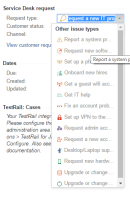-
Type:
Suggestion
-
Resolution: Fixed
-
Component/s: None
NOTE: This suggestion is for JIRA Service Desk Server. Using JIRA Service Desk Cloud? See the corresponding suggestion.
example use cases
- Associate existing tickets and tickets that come through email or various other sources with a Service Desk (when the Customer Request Type field isn't filled in, tickets won't be displayed in the Customer Portal).
- Move tickets between Service Desks (triage).
- Create and move tickets on customers' behalf, e.g. after a phone call.
- is related to
-
JSDSERVER-55 Issues created before Service Desk will not show in the user's portal
- Closed
-
JSDSERVER-193 Customer Request Type in Basic Search
- Gathering Interest
-
QUALITY-266 Loading...
- relates to
-
JSDSERVER-38 As an admin I want Service Desk to recognise issues created by Mail Handlers and through the standard Create Issue
-
- Closed
-
-
JSDCLOUD-42 Allow "Customer Request Type" to be manually edited
- Closed
-
JSDSERVER-24 As a service desk customer, I would like to have the ability to have an "email based" workflow for the users that don't want to go to the portal
- Closed
- supersedes
-
JSDSERVER-281 Changing Issue Type does not update the Customer Request Type
-
- Closed
-

